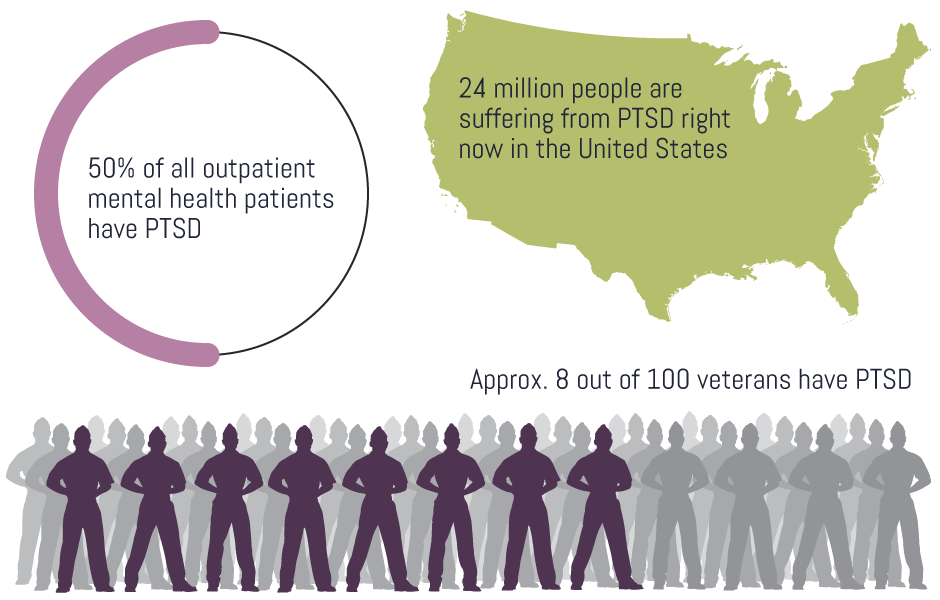Post Traumatic Stress Disorder
Post Traumatic Stress Disorder
- People with PTSD have among the highest rates of using healthcare services
- The cost of PTSD-related anxiety disorders is more than $42.3 billion annually
- PTSD affects adults as well as children
- Approximately 50% of all outpatient mental health patients have PTSD
- Approximately 24 million people are suffering from PTSD right now in the United States
- The risk for PTSD is much higher in war veterans.2 Approx. 8 out of 100 veterans have PTSD.(3)

The Signs of PTSD
Common Causes of PTSD
Sexual Violence
One common cause of PTSD is experiencing sexual violence or assault as a child or as an adult. Any form of sexual contact that occurs without an adult’s consent or that violates a child’s or adult’s sense of control, autonomy, and command over their own body can cause PTSD.
Military Service
Throughout the 20th century, soldiers who suffered lasting mental health effects after combat were deemed to be “shell-shocked” or “battle fatigued”. We now recognize these conditions as being PTSD that comes from being in traumatizing combat events.
Natural Disaster
People who experience stressful natural disaster events such as hurricanes, fires, earthquakes, tsunamis, and tornadoes can feel overwhelmed at the sudden devastation they experienced. The initial shock can then become PTSD.
Traffic Accident
Traffic accidents happen suddenly with little or no warning. The trauma associated with a crash can lead to PTSD, particularly if the person has had past trauma(s), if the traffic accident was life-threatening, or if the person has other mental health conditions.
Serious Injury
An experience that causes serious injury can bring shock and horror. The physical consequences and psychological aftereffects can contribute to the onset of PTSD.
Understanding the Effects of PTSD
Symptoms of PTSD
You may be experiencing PTSD if you have a cluster of emotional symptoms, which include:
Anxiety: You’re constantly anxious that there may be danger around you
Anger: You lash out in anger for no apparent reason
Depression: You feel depressed due to misplaced guilt
Irritability: You are frequently irritable or moody
Sadness: You often feel sad for no apparent reason
Physical symptoms can manifest with PTSD, including:
Fatigue: You feel tired all the time
Increased perspiration: You sweat a lot more than you did prior to the traumatic event
High or low blood pressure: Your blood pressure is either above or below normal
Digestion issues: You often find it hard to digest food
Children and teens can have severe reactions to trauma, but their symptoms can appear differently from adults. In children under 6 years old, the following symptoms can appear:
• Bedwetting after successful toilet training
• Forgetting how to or being unable to talk
• Acting out the scary event while playing
• Unusual clinginess with parents or other adults
Older children and teenagers generally show symptoms similar to adults. Additionally, they may develop behavioral problems, such as being disrespectful, disruptive, or destructive. They may feel misplaced guilt for not “saving” others. They may also have thoughts of suicide or revenge.
Risk Factors for PTSD
Some factors that increase risk for PTSD include:
• Surviving a dangerous event and trauma
• Childhood trauma
• Getting injured
• Seeing another person injured
• Seeing a dead body
• Feeling scared, helpless, or experiencing extreme fear
• Added stress after the trauma experience, such as injury or loss
• Experiencing little or no social support after the traumatic event
• Having a mental illness or substance abuse history
• Finding support after a traumatic experience
• Searching out support from loved ones
• Having positive coping skills to get through the trauma and learning from it
• Learning to feel competent about your own actions when facing danger
• Being able to respond competently despite fear
PTSD Treatments
Currently, people with PTSD are treated with medications and psychotherapy. Since everyone is affected differently from PTSD, treatment must be designed for the particular person, because what may work for one person may not work well for another.
If you have PTSD, it’s important you seek help from a mental health professional who has experience treating this disorder. You may have to try several different treatments to find what works best for you. If you have other issues, such as ongoing trauma, depression, or substance abuse, you’ll need to treat all the co-occurring issues at the same time for effective recovery.
There are other types of treatment for PTSD, and you can discuss these options with your therapist. Effective treatment should help you manage your symptoms and get you back on track to the way you were before the trauma.
Medication has been proven to be an effective treatment for PTSD. According to the National Center for PTSD, 42 out of 100 people who take medication will no longer meet the guidelines for PTSD.(3) Medications may be prescribed along with psychotherapy. Medications that effectively treat PTSD include:
Antidepressants: To reduce sad feelings, anger, numbness, and worry
Alpha-adrenergic Blockers: To help regulate blood pressure and relieve nightmares
Anti-anxiety medications: Short-term use of these drugs can help relieve severe anxiety
Psychotherapy, also known as talk therapy, can help PTSD sufferers work through the trauma. According to the National Center for PTSD, 53 out of 100 people who receive PTSD psychotherapy treatment will no longer meet the guidelines for PTSD.(3)
Psychotherapy involves talking with a mental health professional regarding a mental health disorder like PTSD. Psychotherapy can be conducted on an individual basis or within a group. Treatment sessions typically run from 6 to 12 weeks, but can go longer when needed. You’ll learn about trauma and its effects, relaxation techniques, anger control, and how to live a healthier lifestyle.
Psychotherapy can help people with PTSD by addressing the symptoms directly or by focusing on PTSD-related problems. Mainly, therapy sessions include PTSD education, learning skills to help identify symptoms triggers, and how to manage symptoms.
Exposure therapy, a form of CBT (cognitive behavioral therapy) can help you confront and control your fear. You’ll be slowly and safely exposed to the trauma. Methods used to do this are writing, imagining, or visiting the place where the event occurred. Your therapist uses these methods to teach you coping skills.
There are other types of treatment for PTSD, and you can discuss these options with your therapist. Effective treatment should help you manage your symptoms and get you back on track to the way you were before the trauma.
PTSD Myths and Misconceptions
Misconception: PTSD only happens in the military
War veterans are seriously affected by PTSD, but they are not the only segment of the population that’s affected. Even children can get PTSD, and it can happen to anyone at any age.
Misconception: PTSD happens right after a traumatic ordeal
Typically, PTSD symptoms start about 3 months after a trauma. In many cases, the symptoms begin many months or years later. For some, symptoms are continuous, and for others they appear, disappear, and then reappear. If symptoms don’t occur right after an event, it may be hard for the person to make the connection between the symptoms and the trauma.
Misconception: People who have PTSD should just snap out of it
Some people readjust after a traumatic ordeal, but others can’t, and this has nothing to do with mental weakness. There are many factors that determine if someone will get PTSD, such as the type, severity, and the length of the traumatic ordeal, the individual’s personality, the way the brain releases stress chemicals, and if the person had past trauma or has a solid support network.
PTSD Self-Care Strategies
There are steps you can take outside of treatment to help yourself deal with PTSD. While it may be difficult, with treatment and your own management, you can recover.
You can also care for yourself by:
• Letting a trusted friend or relative know what you are experiencing
• Letting those around you know what may trigger PTSD symptoms
• Doing gentle physical activities or exercises to release stress
• Setting realistic goals for yourself
• Breaking up tasks into smaller, more manageable ones.
• Trying to spend time with friends or family
• Identifying and going to places or being with people you feel comfortable with
• Reducing or eliminating caffeine and nicotine intake as they can worsen anxiety
• Avoiding self-medication with drugs or alcohol to cope
• Giving yourself time to recover, it doesn’t happen immediately
Common Co-Occurring Conditions with PTSD
Finding Help With PTSD
Resources for PTSD treatment are increasing in the United States for veterans and non-veterans as awareness grows that it is a real problem that can be effectively treated with the right help.
The NAMI Helpline is a good place for people who are non-veterans to find effective treatment.
THE NAMI NATIONAL HELPLINE 800-950-NAMI
For veterans, the Veterans Administration has PTSD programs offering treatment for combat-related conditions.
NATIONAL DIRECTORY OF VA SERVICES 1-800-273-TALK
Instead of isolation and self-medication, reach out for help if you find yourself experiencing PTSD symptoms, even if the trauma ordeal may have happened months or years ago.

We Work With Most Major Insurance Providers
The Safe Harbor Treatment Admissions Team works to ensure that we can help as many people struggling with substance abuse. Verify your benefits now and we’ll get back to you right away.
Receive the highest level of care available at Safe Harbor. We are here to answer your call or fill out our confidential contact form to get started.
http://www.ptsdunited.org/ptsd-statistics-2/
http://www.namiarizona.org/page17/page34/index.htmlhttps://www.ptsd.va.gov/
https://www.ncbi.nlm.nih.gov/pmc/articles/PMC3811127/
https://www.ncbi.nlm.nih.gov/pmc/articles/PMC2760665/
https://www.ncbi.nlm.nih.gov/pmc/articles/PMC4346088/
https://www.ncbi.nlm.nih.gov/pmc/articles/PMC4579516/
https://www.ncbi.nlm.nih.gov/pmc/articles/PMC4518698/

